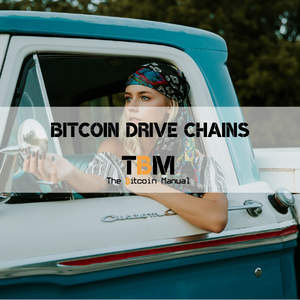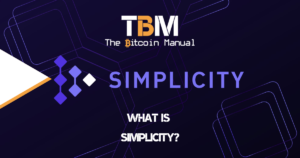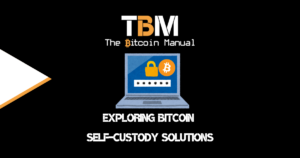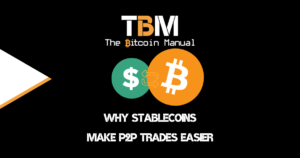Drivechains
Home » Blockchain » Drive Chains
Bitcoin’s ability to scale relies on adding layers above it that remain interoperable with the base chain and can use the bitcoin blockchain as a final settlement, if and when needed. There are several types of layer two solutions, with Drivechains being another option for the growing stack. Drivechain allows Bitcoin to create, delete, send BTC to, and receive BTC from “Layer-2” s called “sidechains”. Sidechains are separate chains or protocols that lack a native “coin” – instead, pre-existing coins from a different blockchain; in this case, bitcoin must first be sent over.
Once on a sidechain, coins can change hands an unlimited number of times and in an unlimited number of new ways. Thus, BTC-owners can opt-in to new features or tradeoffs. Meanwhile, the Bitcoiners who don’t opt-in never need to care what any sidechain is doing.
Transfers from the sidechain back to the main chain (i.e., from Layer 2 back to Layer 1) are not done via verifiable proof but via conjecture and refutation. A “bundle” of transfers is asserted and slowly “ACKed” over time. After three months of ACKing, the bundle succeeds. Thus, the SC: BTC market price cannot deviate significantly from the 1:1 ratio.

What are drivechains?
Drivechain is a project that seeks to leverage sidechain technology in order to introduce additional functionality to Bitcoin. The project aims to achieve this by using pegged sidechains, which would allow any individual to move their bitcoins to a variety of pegged blockchains.
Having multiple sidechains would, in theory, provide users and wallet developers more freedom to create financial products as they could leverage different chains for different features. Resulting in a scenario in which one would be able to move their bitcoins to, for example, a pegged sidechain that supported smart contract technology or a pegged sidechain that employed privacy technology such as ring signatures.
The relationship between the mainchain (which would be the Bitcoin blockchain) and the pegged sidechains is that the transferability of bitcoins would be bidirectional. Thus, one would be able to transfer their bitcoins from the main chain to a pegged sidechain and back.
How do drivechains work?
Drivechain and 2-way peg
Drivechains intend to utilise sidechains such that they are child sidechains of a parent chain, which would be the Bitcoin blockchain. Central to the sidechain architecture proposed by Drivechain is the 2-way peg, which would allow for the movement of bitcoins from the Bitcoin blockchain to a sidechain and back.
The 2-way peg functions by first requiring a user to transfer bitcoin to a special output on the Bitcoin base chain. This output can only be unlocked by an SPV proof of possession on the sidechain. When a user wishes to transfer their bitcoins back to the Bitcoin blockchain, they perform the same steps required with the original transfer.
They send the bitcoin currently on the sidechain to an SPV-locked output, produce an SPV proof verifying that this action took place, and then use the SPV proof to unlock the number of previously-locked outputs that contain an equal denominated amount of bitcoins on the Bitcoin chain.
An SPV proof, or simplified payment verification proof, is a DMMS (dynamic-membership multi-party signature) that an action occurred on a Bitcoin sidechain. An SPV proof is effectively comprised of a list of block headers demonstrating proof of work and also a cryptographic proof that an output was created in one of the blocks in the list.
An SPV proof allows a verifier to check that some amount of proof of work mining has been committed to result in the existence of an output. SPV proofs ensure that verification as to the transfer of bitcoins by a user to and from blockchains can take place.
Drivechain hashrate escrow
Drivechain is formed of two critical components:
- Hashrate escrow
- Blind merged mining.
A hashrate escrow functions similarly to a 2-of-3 multi-signature escrow, however, with a hashrate escrow, the third party (who will be responsible for arbitrating any disputes) is a decentralised group of Bitcoin miners.
This third party will, instead of signing an escrow-withdrawal transaction with a private key, do so instead by directing hashpower over them for a certain period of time. According to the Drivechain team, these hashrate escrows are likely to be ‘asymmetric sidechains’ of Bitcoin.
The 2-way peg described previously can be thought of as being a ‘symmetric 2-way peg’, because the transfer mechanism from the Bitcoin chain to the sidechain were identical, both had SPV security.
However, with an asymmetric 2-way peg, users of the sidechain would be full validators on the Bitcoin chain, and transfers from the Bitcoin blockchain would not require SPV proofs, as validators would be already aware of the state of the Bitcoin chain.
In the case of the sidechain, the bitcoin chain would be unaware of the sidechain. Thus, SPV proofs would be required to initiate a transfer back to the Bitcoin chain.
Drivechain blind merged mining
The second component comprising Drivechain is blind merged mining, which is a variant of merged mining. Merged mining is the process of reusing proof of work solutions from a parent cryptocurrency as valid proofs for one or more child cryptocurrencies. Since a miner would be utilising hashing power on one or more child cryptocurrency networks, they would be entitled to the rewards on these blockchains.
Merged mining was introduced as a solution to the fragmentation of mining power among competing cryptocurrencies. Instead of fragmenting mining power, smaller cryptocurrency networks can benefit from merged mining in the form of increased mining power, which allays concerns of security that is often levied against smaller cryptocurrency networks.
Blind merged mining is intended to address two drawbacks found with traditional merged mining:
- Miners must run a full node on the child chain.
- Miners are paid on the child chain and not the parent chain.
With blind merged mining, a miner on the parent chain can mine on a sidechain without having to do any validating on the sidechain.
Drivechain introduces a novel type of transaction, where the sidechain node wants the mainchain miner to include, what the Drivechain team describes as a ‘critical hash’, into the coinbase of a mainchain block. Inclusion of the critical hash into the coinbase would signify that the sidechain block would have been successfully merge-mined.
If a sidechain node can successfully merge-mine their block, they can claim the block reward on that sidechain. The mainchain miner is paid by the sidechain node when the sidechain node requests for the critical hash to be included in the coinbase of the mainchain block.
This solves the issues identified with traditional merged mining, as miners on the mainchain do not have to run a full node on the child sidechain, and are also compensated for their services in bitcoin, the native asset of the mainchain.
What are the benefits of drivechains?
As is the base with other side chains, Drivechains provide additional features that may not be ideal for placement on the base chain.
Reduce infighting
Sidechains like drive chains allow for experimentation instead of trying to change the base layer. This removes existential threats to BTC such as – altcoin competition, hard fork campaigns, and extension block campaigns.
Reduced attack vectors
BTC development becomes anti-fragile with respect to CoreDev mistakes, but with Drivechains, you’re not touching the core Bitcoin code, meaning less likelihood of making critical mistakes or introducing bugs that could affect the primary network.
Maintain resource focus
Instead of having layers compete for resources, sidechains allow the BTC main net to function as normal and focus hashrate security where it belongs as well as node consensus.
Adding scalability
BTC can scale to credit-card level txn-processing – without changing the CONOP of Bitcoin Core. These cheap txns have optimal fungibility and supply vital pretext to the BTC ecosystem.
New functionality
Once bitcoin has been locked on the base layer and the proof is sent to the Drivechain, that value can then be exchanged using different methods of consensus. This means BTC lives in a new environment with fewer constraints and gains new, experimental abilities, especially P2P event derivatives.
What are the downsides of drivechains?
The two big critiques of Drivechain are:
- “miners-can-steal” – 51% hashrate can empty the Bip300 sidechain of funds, sending them to a txn of their own choosing.
- “miner side-hustle” – It is bad if miners can make money on a side-hustle, because then miners will feel pressured to do the side-hustle. The side-hustle might negatively affect users of Layer1.
What are drivechain BIPs?
- BIP 300 (Hashrate Escrows) – “Container UTXOs” that compress 3-6 months of transaction data into a fixed 32-bytes.
- BIP 301 (Blind Merged Mining) – A technique to replace the act of running a sidechain node with the act of including a single high-fee transaction.
More resources on drivechains
Share with a friend
If you thought this information was helpful why not share it on your favourite social media network and encourage others to learn more about Bitcoin
The latest news from our blog

What Is Simplicity?
One of the criticisms often levelled at Bitcoin is its limited scripting capabilities, which restrict the complexity of smart contracts. If you ever speak to

Exploring Bitcoin Self-Custody Solutions
The concept of self-custody is at the heart of Bitcoin’s philosophy. Not your keys, not your coins. By owning your private keys, you take complete

Why Stablecoins Make P2P Trades Easier
Acquiring Bitcoin through peer-to-peer (P2P) trading was the default method of acquiring the asset if you didn’t have your own mining set up back in
